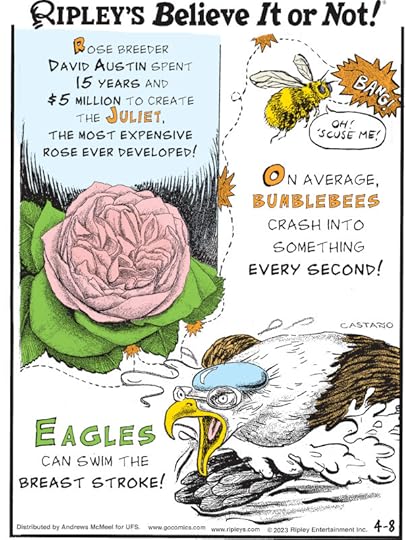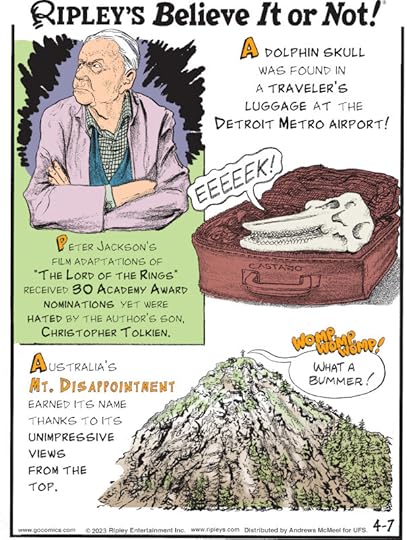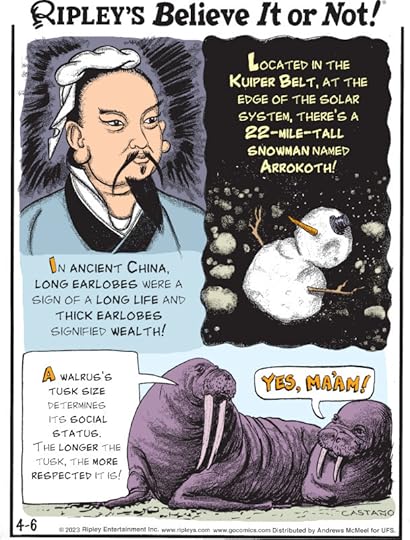Ripley Entertainment Inc.'s Blog, page 33
April 11, 2023
‘Ice Age’ Discovery: 30,000-Year-Old Squirrel Found in Canada
Featured in Ripley's Believe It or Not!
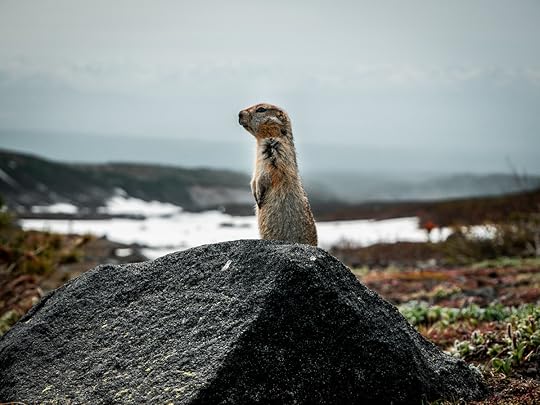
The Ice Age franchise that began in 2002 contains many hilarious scenes featuring Scrat, a saber tooth squirrel. The fuzzy guy gets into plenty of trouble during various acorn-driven escapades. You could even categorize these misadventures as downright catastrophic. Among the most famous episodes is his attempt to bury a prized acorn. It leads to an unintended crack in the ice, sending a glacier hurtling towards the scraggly rodent.
Scrat’s pursuit of shiny acorns leads to his accidental preservation in a block of ice, only to turn up 20,000 years later in Hawaii. A quick thaw puts him back on the quest for acorns, though he eventually settles on a coconut instead. Despite the whimsical nature of the plot, a recent scientific discovery includes a surprising shoutout to Scrat.
Keep reading for the full scoop on the 30,000-year-old fur ball scientists recently revealed contains a real-life ice age squirrel.
The Mystery of the Fur ballWhile a 30,000-year-old Arctic squirrel fossil sounds fantastic on its face, what gold miners uncovered in Canada in 2018 was anything but pretty. A ball of claws and fur, the unrecognizable object had researchers scratching their heads. Some declared it a “mangled lump of mummified flesh,” giving it little more thought.
But a recent reexamination of the fur ball in preparation for its display at Whitehorse’s Yukon Beringia Interpretive Centre (YBIC) has uncovered a far more fascinating story. As it turns out, the fur ball is none other than a fully intact mummified squirrel, preserved mid-hibernation at some point in the distant past.
The clump of brown fur and skin was no ordinary furball; it contained tiny hands, claws, ears, and a tail.https://t.co/rsySu0Y5hp
— Interesting Engineering (@IntEngineering) April 4, 2023
Paleontologist Grant Zazula of the Yukon government notes, “It’s not quite recognizable until you see these little hands and these claws, and you see a little tail, and then you see ears.”
The mystery of the fur ball was solved!
Identifying the Scrat-Like Critter Preserved in TimeAlthough the fuzzy mummified ball isn’t about to melt or return to life like Scrat, the critter still tells an extraordinary story. Scientists now believe the ball represents a curled-up Arctic ground squirrel (Urocitellus parryii).
Remarkably, this ancient species still lives where the “permafrosted” squirrel was uncovered. They look more like gophers than squirrels. But they still hibernate and flourish in Canada’s Yukon Territory. A representative from the YBIC explains, “It’s amazing to think that this little guy was running around the Yukon several thousand years ago.”
The remarkable find recently yielded more information thanks to X-ray scans. Researchers initially feared the mummification process and the artifact’s great age meant a deteriorated skeletal structure. But the scans provided evidence of a highly preserved bone structure nearly identical to that of Arctic ground squirrels today.
A Location Rich With Ancient Discoveries
We’re excited to share a few pictures of a ~30,000 year old arctic ground squirrel. We were able to get some incredible x-rays of the squirrel’s remains. You’ll be able to see this incredible specimen on display at the Beringia Centre very soon! #MuseumMonday #IceAge #fossil pic.twitter.com/txXlW0Qu5Y
— Yukon Beringia Interpretive Centre (@yukonberingia) March 28, 2023
Scrat-like squirrels aren’t the only things being uncovered in Canada’s Yukon. In 2016, gold miners made another stunning find: the remains of a 57,000-year-old grey wolf (Canis lupus) puppy.
Like the fur ball/squirrel, the wolf puppy remains remarkably intact. Julie Meachen of Des Moines University in Iowa explains, “She is the most complete wolf specimen ever found from the ice age. All her soft tissue, her hair, her skin, even her little nose is still there. She’s just complete. And that is really rare.”
Something you don’t see every day – a 57,000-year-old Ice Age grey wolf pup. #MammalMonday
Found in thawing permafrost in the Klondike goldfields, near Dawson City, Yukon, Canada, this ~40 cm long mummified pup is a female and represents the most complete wolf mummy known. pic.twitter.com/q8sNoSM4aA
— Dr Dean Lomax (@Dean_R_Lomax) January 4, 2021
Several years later during the summer of 2022, Canadian gold miners discovered a perfectly preserved juvenile mammoth. Further examination dated it to 30,000 years ago, like the squirrel fur ball. In other words, Canadian researchers have found unlikely representatives for two of the three “subzero heroes” from Ice Age — Scrat the squirrel and Manny the mammoth. As for Sid the sloth? The ice-cold hunt continues.
By Engrid Barnett, contributor for Ripleys.com
EXPLORE THE ODD IN PERSON! Discover hundreds of strange and unusual artifacts and get hands-on with unbelievable interactives when you visit a Ripley’s Odditorium!Source: ‘Ice Age’ Discovery: 30,000-Year-Old Squirrel Found in Canada
CARTOON 04-11-2023
April 10, 2023
CARTOON 04-10-2023
April 9, 2023
CARTOON 04-09-2023
April 8, 2023
CARTOON 04-08-2023
April 7, 2023
An Australian Company Created A Meatball Made Of Woolly Mammoth
Featured in Ripley's Believe It or Not!
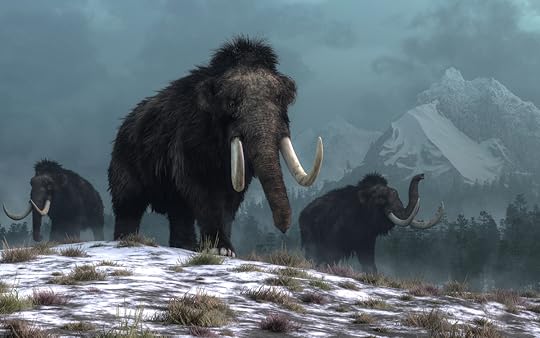
Would you eat a meatball made of lab-grown meat? What if the meat was made from the genetic material of a woolly mammoth? If your answer was yes, the Australian startup Vow has your delectable culinary artifact!
Vow created the cultivated meat using the pachyderm’s cells, so we could potentially being seeing the extinct mammal on our dinner plates someday!
Mammoth MeatUsing publicly available genetic information, the company supplemented the process using genetic material from an African elephant, which is the mammoth’s closest living relative. This material was injected into a sheep cell, the cells multiplied, and they grew large enough to make a giant meatball (between the size of a softball and volleyball).
Also referred to as cultured or cell-based meat, company founder Tim Noakesmith told the Associated Press that it’s an environmentally friendly alternative to animal meat because no livestock is killed in the process. Unfortunately, you cannot order a mammoth meatball just yet. You won’t see any advertisements for “Mammoth meatballs coming soon!” It is still in the experimental stage, and even its creators haven’t tasted it. But the publicity the mammoth meatball has garnered has gotten people talking.
Lab grown meat is amazing.
You can now eat meat from extinct animals.
This is a woolly mammoth meatball
(Presented March 28th in the Netherlands) pic.twitter.com/3wZc4SrnkW
— Daily Dose (@ddofinternet) March 31, 2023
“We wanted to get people excited about the future of food being different to potentially what we had before,” Noakesmith told AP. “That there are things that are unique and better than the meats that we’re necessarily eating now, and we thought the mammoth would be a conversation starter and get people excited about this new future.”
While no one has tasted the giant meatball, those working on it did smell it, and it had a pleasant aroma. “The folks who were there, they said the aroma was something similar to another prototype that we produced before, which was crocodile,” Noakesmith said. “So, super fascinating to think that adding the protein from an animal that went extinct 4,000 years ago gave it a totally unique and new aroma, something we haven’t smelled as a population for a very long time.”
The Future is… Cultivated Meat?The mammoth meatball is currently on display at the Nemo Science Museum in Amsterdam.
Although you can’t eat the mammoth meatball, Vow plans on producing cultivated Japanese quail meat for diners later this year. But it will only be available for people living in or visiting Singapore–the only country that allows the sale of cell-based meat for human consumption.
Vow is not the only company that is experimenting with cultivated meat products—there are over 100 globally with the same purpose. And it’s intended to help the environment. Meat production around the world involves the use of billions of acres of land, while the production of cultivated meat products does not require that type of real estate.
Noakesmith pointed out that the woolly mammoth died from climate change and is a symbol of loss. “So, what we wanted to do was see if we could create something that was a symbol of a more exciting future that’s not only better for us, but also better for the planet,” he noted.
Meanwhile, the mammoth meatball project has gotten the thumbs up from the non-profit Good Food Institute, which advocates the use of plant- and cell-based alternatives to animal products. Seren Kell, the company’s science and technology manager, told the AP that cultivated meat can potentially lead to the use of more sustainable foods, and it may reduce climate impact. The mammoth project is unique in that involves an unusual food source, versus traditional livestock such as cattle, pigs, and poultry.
By Noelle Talmon, contributor for Ripleys.com
EXPLORE THE ODD IN PERSON! Discover hundreds of strange and unusual artifacts and get hands-on with unbelievable interactives when you visit a Ripley’s Odditorium!Source: An Australian Company Created A Meatball Made Of Woolly Mammoth
CARTOON 04-07-2023
April 6, 2023
The Barney Backlash That Fueled A Generation
Featured in Ripley's Believe It or Not!

Today, we are taking a deep dive into the lovable dinosaur sensation that captivated the minds of children all around the world. That’s right, I am talking about the hit television show Barney & Friends, but what if I told you there was more than meets the eye with the children’s show. Let’s rewind back to the 90’s and take a look at the dark side of a television show that brought out a seemingly irrational hatred in a big portion of our society.
Barney’s BackgroundBarney was a show created by Sheryl Leach and was directed for children between 2-7 years of age. In fact, Sheryl created Barney for her son Patrick when she noticed just how much he enjoyed the show Wee Sing Together. Sheryl noticed that there was a major lack of content for children of his age and in seeing what Patrick reacted to she was able to better craft Barney around the interests of younger children.
Embed from Getty Imageswindow.gie=window.gie||function(c){(gie.q=gie.q||[]).push(c)};gie(function(){gie.widgets.load({id:'JOGAeoEJRmd5Kstl-4Gb3Q',sig:'N0V6aD_CK6GXfFcSv5j08SiV1vpf0Nftmb6bC5_1F2A=',w:'384px',h:'594px',items:'170673469',caption: true ,tld:'com',is360: false })});Barney & Friends began to pick up steam quickly even as it was still relatively low budget. In fact, in the beginning, Sheryl lacked a marketing budget and instead relied on local moms to call their friends or visit local daycares and market to other moms through word of mouth.
Barney & Friends caught on like wildfire as children all over were glued to their televisions singing and dancing along with the friendly purple dinosaur. Barney continued to expand beyond just television as Sheryl moved forward with live shows, birthday parties, and in person appearances as very quickly, Barney the dinosaur became a cultural phenomenon seemingly overnight.
The Barney Backlash BeginsWith such a massive cultural pull, Barney became an early friend to the generation he fostered with his singing, dancing, and educational segments but with so much love of the big purple dinosaur came a dark underbelly of hatred. Believe It or Not!, the Barney backlash ignited nearly as fast as one generation grew to love him; other generations saw him as shallow, annoying, and some even felt that he was pure evil.
One of the earliest examples of the cultural shift on Barney made itself apparent on college campuses. College students, at the time, grew up on Sesame Street with characters like Big Bird and any attempt to tarnish or try to rewrite sacred childhood nostalgia can seem like an act of war.
Enter the “Barney Bashing Events” which were held on college campuses and encouraged students to take their frustration and hatred out on the purple dinosaur. By having dedicated tables with stuffed Barney dolls and hammers, students were encouraged to smash Barney to smithereens. The grand finale of the event was a wrestling match between Big Bird and Barney!
The most interesting aspect of this event is how no matter what the content is, what we grow up on and the childhood nostalgia we have attached to our earliest memories are almost sacred. To see a new generation, have its own form of books, television and characters they hold near and dear can feel as though it is an attack or an effort to white wash the very things the generation before held close to their heart.
The Barney Secret SocietyThe cultural (and literal) bashing doesn’t end there as a growing number of adults found Barney & Friends to be annoying, repetitive, upbeat, and not indicative of the real world. Enter Rob Curran, an ad salesman and disgruntled parent that felt cheated by Barney. After returning home from a business trip rather than being greeted by his daughter, Rob watched as she stayed glued to the television watching Barney.
Rob took the bottled-up anger that other parents were feeling and channeled it through a website and newsletter that he started known as “The I Hate Barney Secret Society.” The newsletter, although satirical in nature, struck a chord with other disgruntled parents and Rob was shocked when he received more than 7,000 letters in six weeks!
This immense response indicated that parents all over related with the feelings that Rob was having towards the purple dinosaur. As Rob’s newsletter continued to publish, his audience grew and actually propelled him to a status of notoriety as he was interviewed on various television shows and publications. Rob became the face of the disgruntled parent that had grown tired of Barney and skeptical to what it was that was holding the attention of their children.
So, there you have it – from the children’s television show of a generation, to bashing events, to disgruntled parents rallying around an all-encompassing newsletter. The cultural shift Barney faced is one of the most interesting spectacles in modern entertainment history! Even as a kid in elementary school, I remember singing songs with friends about hurting Barney or hearing rumors that Barney was evil or satanic. Let me know in the comments below if you have any personal experience with the Barney backlash. Until next time, I’m Jordan Neese, and this is Ripley’s Rewind.
EXPLORE THE ODD IN PERSON! Discover hundreds of strange and unusual artifacts and get hands-on with unbelievable interactives when you visit a Ripley’s Odditorium!The Closest Living Relative Of Extinct ‘Bigfoot’ Found?
Featured in Ripley's Believe It or Not!
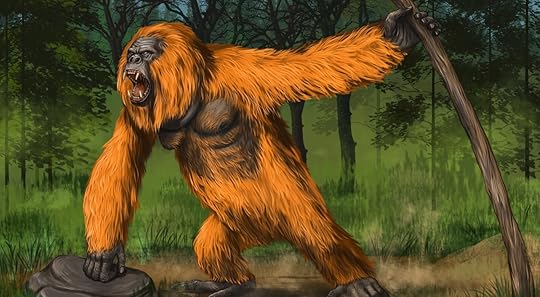
For decades, the legend of Bigfoot has fascinated people around the globe. Is the massive 10-foot-tall ape-like creature with shaggy hair a human relative or a missing link in the evolutionary chain? Despite the lack of concrete evidence, both cryptozoologists and anthropologists continue to search for answers.
Bigfoot has been part of our collective history since its existence was first alluded to in a 1958 local column in the Humboldt Times. Although other giant ape-like creatures were already part of the folklore around the world (like the Abominable Snowman of the Himalayas) by then, journalist Andrew Genzoli brought the beast home when he recounted the story of a road construction crew that had run into huge humanoid “16-inch tracks in the vicinity of Bluff Creek.”
Genzoli had written the story almost as an afterthought (when he couldn’t come up with enough words for his column), but it immediately hit a cord across the nation. Soon, everybody was calling the creature behind the giant footprints “Bigfoot” — and what started as a casual story soon became the stuff of legends. Today, thousands of aficionados search for Bigfoot regularly in the forests of North America. There’s even a Bigfoot Field Researchers Organization, which documents sights around the country and engages in “projects, including field and laboratory investigations” to study the Bigfoot phenomenon.
Could Bigfoot Be Real?Did a massive ape creature walk the Earth in our long-lost past?
Long before we ever heard of a mythological ape roaming North America, a very real, Bigfoot-like animal called the forests of South Asia home.
Meet Gigantopithecus, an ape that went extinct about 300,000 years ago. Scientists didn’t even know of its existence until 1935, when a German paleoanthropologist stumbled on a huge molar at – of all places – a traditional Chinese pharmacy in Hong Kong.
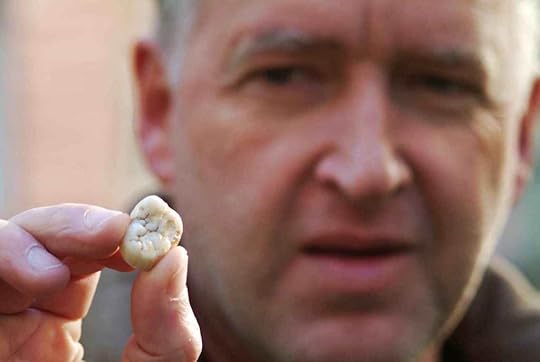
Molar of Giganthopithecus. Credit: Gerbil Via Wikimedia Commons (CC BY-SA 3.0).
Once researchers learned about Gigantopithecus and started actively searching for fossils, more teeth and jaws turned up in China, Indonesia, Thailand, and Vietnam. Gigantopithecus was once described as the “largest hominoid (a subfamily that also includes humans) that ever lived” but has more recently been reclassified as a close relative of the extinct Sivapithecus ape and modern-day orangutans.
No Gigantopithecus bones have ever been found, so scientists can only speculate as to what the giant ape looked like. The best guess is that it was at least 10 feet tall and possibly weighed as much as 1,200 pounds. As a comparison, the largest modern-day ape (the gorilla) weighs “only” 400 pounds.
How Being a Vegetarian Didn’t Pay Off For GigantopithecusGigantopithecus likely inhabited the Earth for over 1.5 million years, eventually disappearing about 300,000 years ago. While scientists don’t know much about the giant ape, they do know one thing (almost) for sure — they were vegetarians.
It’s obvious from the teeth and jaws found that Gigantopithecus’ diet consisted mainly of “tough, fibrous plants,” fruits, seeds, and bamboo. This sugar-rich diet — which not only wore down the teeth but also caused cavities — is likely what eventually led to Gigantopithecus’ extinction. This is because bamboo has been known to go through periods of poorly explained “mass die-offs.” And when you’re a giant ape with a giant appetite and your main source of food suddenly disappears, your chances for survival just aren’t that good.
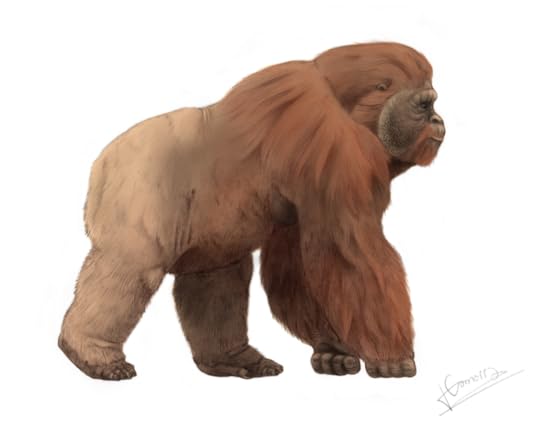
Credit: Concavenator Via Wikimedia Commons (CC BY-SA 4.0).
In 2013, a team of scientists from the Chinese Academy of Sciences speculated that climate change, low birth rates, and the appearance of Homo erectus encroaching in its territory could have also played a role in the extinction.
Is That Where the Legend of Bigfoot Comes From?While modern humans didn’t share the planet with Gigantopithecus, we know our ancestors did. Could they have left behind some clues of the existence of a giant ape-like creature? And if a giant ape once roamed the world, is it really impossible for one to still exist today?
Native American tribes in the Pacific Northwest have passed down stories about the Sasquatch for generations. During a podcast interview, journalist Laura Krantz explained that many Native American stories talk about experiencing, smelling and hearing Sasquatch, and that there are curious petroglyphs in Oregon of something that resembles a giant ape. “There’s carvings in the rocks that look and say it’s Bigfoot,” Krantz explains during the interview. Or, perhaps, an even older memory of another giant ape that once roamed the same area.
If Bigfoot Exists, How Come We Can’t Find It?Have you ever wondered, when hiking in the wilderness, why aren’t forests littered with animal bones? Forests, mountains, and valleys are rich in animal life, but it’s still incredibly rare to run into carcasses while leisurely strolling around (that would certainly kill our love of hiking!). Scientists point out that this is because animal bones aren’t always easy to find.
Gigantopithecus is a good example. Despite its giant size, researchers haven’t, so far, been able to find anything except teeth and partial jaws.

Lower mandible of Gigantopithecus blacki. Credit: Wilson44691 Via Wikimedia Commons (CC BY-SA 3.0).
This is in part because environments such as rainforests, where Gigantopithecus lived, are living, always- changing organisms. Carcasses decay quickly or are eaten by other animals in the rainforest, and large predators can easily grab bones and carry them away or destroy them.
Anything left to rest on the ground would eventually be covered by nature, buried under soil or roots, or become part of the food chain. It’s very possible bones of Gigantopithecus could still be found in the thick rainforests of Asia, but when dealing with an ever-growing environment, searching for them could take centuries.
Scientists believe this is likely the case for Gigantopithecus. Because DNA degrades quickly in warm, humid regions of the world, even if fossils were found, it might be impossible to confirm their origin.
Meet Gigantopithecus’ Cousin, the Gentle OrangutanSo if there are no bones, how do scientists know Gigantopithecus and modern-day orangutans are related?
Researchers from the Chinese Academy of Sciences were able to extract a protein sequence from Gigantopithecus’ teeth and compared it to the one found in orangutans today. The result? You guessed it — Gigantopithecus is not a close human relative, but they quite resembled modern orangutans.
While this can’t tell us exactly what the extinct giant ape looked like, doesn’t it make the idea of Bigfoot just a little more credible?
By Diana Bocco, contributor for Ripleys.com
EXPLORE THE ODD IN PERSON! Discover hundreds of strange and unusual artifacts and get hands-on with unbelievable interactives when you visit a Ripley’s Odditorium!Source: The Closest Living Relative Of Extinct ‘Bigfoot’ Found?
CARTOON 04-06-2023
Ripley Entertainment Inc.'s Blog
- Ripley Entertainment Inc.'s profile
- 52 followers






